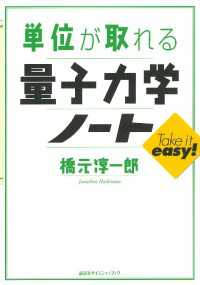- ホーム
- > 洋書
- > 英文書
- > Literary Criticism
Full Description
Laughter, Literature, Violence, 1840-1930 investigates the strange, complex, even paradoxical relationship between laughter, on the one hand, and violence, war, horror, death, on the other. It does so in relation to philosophy, politics, and key nineteenth- and twentieth-century literary texts, by Edgar Allan Poe, Edmund Gosse, Wyndham Lewis and Katherine Mansfield - texts which explore the far reaches of Schadenfreude, and so-called 'superiority theories' of laughter, pushing these theories to breaking point. In these literary texts, the violent superiority often ascribed to laughter is seen as radically unstable, co-existing with its opposite: an anarchic sense of equality. Laughter, humour and comedy are slippery, duplicitous, ambivalent, self-contradictory hybrids, fusing apparently discordant elements. Now and then, though, literary and philosophical texts also dream of a different kind of laughter, one which reaches beyond its alloys -a transcendent, 'perfect' laughter which exists only in and for itself.
Contents
1. Preface: Allegories of Laughter. I. Comedy and Hybridity. II. Laughter and Annihilation.- 2. His 'Last Jest': On Laughter, Edgar Allan Poe and 'Hop-Frog'. I. Comedy and Horror. II. Laughter and Democracy. III. Laughter and Leap-Frog.- 3. 'Unseemly Levity': On Memoirs, Humour and Edmund Gosse. I. Humour and Genre. II. Humour and Emotion. III. Humour and Text. IV. Humour and Beyond.- 4. 'Perfect Laughter': On War, Wyndham Lewis and The Wild Body. I. Laughter and Dualism. II. Laughter, Dualism and Bodies. III. Laughter, Dualism, Bodies and Anarchism.- 5. Epilogue: 'Derisive Laughter': On Superiority, Katherine Mansfield and 'Miss Brill'.



![[魂の目的]ソウルナビゲーション - あなたは何をするために生まれてきたのか (改訂新版)](../images/goods/ar2/web/imgdata2/41986/4198650144.jpg)



